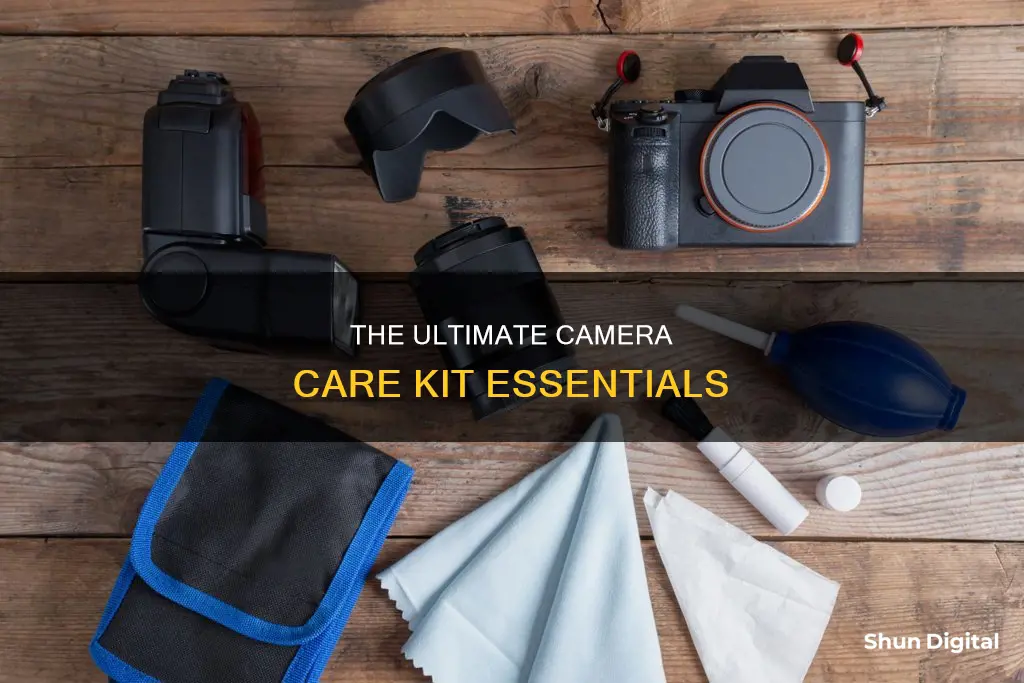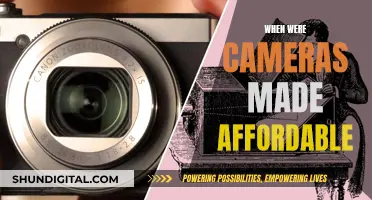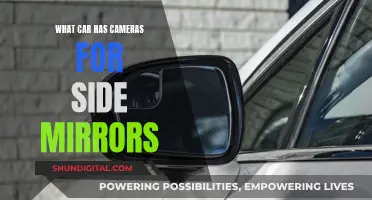
A camera care kit is essential for keeping your camera in good condition and ensuring it has a long life. Here are some of the key items that should be included in a camera care kit:
- A camera bag to protect your equipment from scratches, dust, and rain.
- Cleaning equipment such as microfiber cloths, brushes, and liquid solutions specifically designed for cleaning camera lenses and LCD screens.
- A remote shutter release to help with group photos, long exposures, and photographing distant subjects.
- Spare batteries and a battery charger to ensure your camera never runs out of power.
- A tripod to keep your camera steady and reduce blur in low-light conditions or when using slow shutter speeds.
- A lens cleaning kit, including sensor cleaning swabs and fluid, to remove dust and dirt from your camera sensor.
- A flash diffuser to soften the light from a flashgun and create more flattering illumination for portraits and still life images.
| Characteristics | Values |
|---|---|
| Camera bag | Waterproof, protective, comfortable, spacious |
| LCD screen and camera lens cleaner | Microfiber cloth, commercial LCD screen cleaner, liquid solutions, brushes |
| Batteries | Alkaline or lithium, regularly removed and stored |
| Remote shutter release | Infra-Red, Bluetooth, cable-release system, app-based |
| Lenses | Prime, fast, large maximum aperture size, zoom, telephoto, wide-angle |
| Tripod | Lightweight, sturdy, carbon-fibre, aluminium, adjustable height |
| Memory card | SD, CFast, XQD, CF, large storage capacity, fast |
| Camera strap | Neck, shoulder, wrist, padded, comfortable |
What You'll Learn

Camera bag
A camera bag is an essential piece of equipment for any photographer, protecting your gear from scratches, dust, and water damage. When choosing a camera bag, it's important to consider the type of photography you do and the amount of gear you need to carry. Here are some tips to help you choose the right camera bag:
- Landscape photographers: Opt for a camera or hiking backpack, as they allow you to carry your equipment over long distances.
- Street and vacation photographers: A shoulder bag is ideal for quick access to your gear, but keep in mind that carrying a heavy load on one shoulder can be uncomfortable for extended periods.
- Wedding photographers: Consider a camera backpack or rolling suitcase to accommodate all the equipment you need for the event. A shoulder bag can also be useful for moving around during the wedding.
- Studio photographers: If you don't need to travel with your gear, you may not need a bag. Otherwise, a rolling suitcase is a good option for transporting your equipment.
When selecting a camera bag, it's crucial to ensure it has well-padded compartments to protect your camera and accessories. Additionally, opt for a bag with some spare capacity to accommodate future purchases or accessories. If you need to carry a laptop or tablet, look for a bag with dedicated padded compartments for these devices.
Another factor to consider is the style of the bag. While traditional camera bags were often boring and beige, today's market offers a wide range of styles to suit different tastes and budgets. You can choose from various colours and designs, including discreet options that don't scream "expensive camera gear." For example, the Jo Totes Gracie Camera Bag is designed specifically for female photographers and doesn't look like a typical camera bag while still offering the necessary padded compartments.
Lastly, when it comes to comfort, it's best to try out different bags in person, as everyone has unique preferences and needs. If you plan to buy online, opt for retailers with good return policies, such as Amazon, Adorama, B&H, or REI.
Charging VHS Camera Batteries: A Step-by-Step Guide
You may want to see also

Tripod
A tripod is an essential piece of equipment for any photographer, helping to stabilise videos or stills. When choosing a tripod, there are several factors to consider, including height, weight, stability, ease of use, and special features. Here are some key points to keep in mind:
Height and Weight:
- Look for a tripod that can extend to a suitable height for your needs. Our top pick, the Vanguard Alta Pro 2+ 263AB100, reaches a maximum height of 68.2 inches, making it a good option for taller photographers.
- Consider the weight of the tripod, especially if you plan to travel with it. Lighter tripods are more portable but may sacrifice some stability. The Manfrotto Element MII, for example, weighs only 3.4 pounds, making it ideal for travel.
Stability:
- Stability is crucial, especially when using heavier camera equipment. Look for tripods with a high load capacity to ensure they can support your camera and lens combination.
- Some tripods, like the Vanguard VEO 3T+ 234AB, include a hook at the bottom of the center column to hang a camera bag or other weights, enhancing stability.
- Spiked feet, such as those on the Sirui W-1004K10 Tripod, can also improve stability on soft or uneven surfaces.
Ease of Use:
- Consider tripods with easy-to-use leg locks, such as twist or flip locks. The Vanguard Alta Pro 2+ 263AB100 features twist locks that unlock with a simple quarter-turn, making setup and breakdown quick and easy.
- A bubble level on the tripod can help ensure your camera is level, especially when shooting on uneven terrain.
Special Features:
- Some tripods offer a multi-angle center column, allowing you to position your camera in various ways, which is useful for low-angle or macro shots.
- If you plan to shoot in wet conditions, consider a waterproof tripod like the Sirui W-1004K10, which is designed to keep water and sand out of the joints.
- If you use multiple cameras or devices, look for tripods with dual mounting options, like the Vanguard VEO 3T+ 234AB, which includes an adapter for mounting a second device.
When choosing a tripod, consider your specific needs and budget. While more expensive tripods may offer additional features and stability, there are also many affordable options that provide excellent value and functionality.
Understanding Raw Camera Shooting: Capturing Unprocessed Images
You may want to see also

Remote shutter release
A remote shutter release is a camera trigger system that lets you control your camera without direct contact. This is useful if you want to avoid camera shake when taking a photo. It is also useful when it is impractical or unsafe to be near the camera or subject, such as in wildlife photography.
There are two main types of remote shutter release: tethered and untethered. Tethered shutter releases are cables with a trigger-release mechanism at one end and a camera connector at the other. Untethered shutter releases were originally infrared, with a range of around 16 feet, and required line-of-sight to work. More modern options use Bluetooth or radio frequencies.
When choosing a remote shutter release, consider the type of connection, range, and compatibility with your camera. Some remote shutter releases also offer additional features such as a timer or intervalometer.
- Godox TR-N1 TR-N3 Remote Shutter Release: A wireless shutter release intervalometer compatible with select Nikon cameras.
- Pixel 2.4G Wireless Remote Control DC2: A remote shutter release compatible with select Nikon cameras.
- Canon Wireless Remote Control RC-6: A wireless shutter release compatible with Canon cameras.
- Neewer LCD Timer Shutter Release Remote Control: A remote control with a timer function compatible with select Canon and Pentax cameras.
- Vello FreeWave Plus II Wireless Remote Shutter Release: A wireless remote shutter release for select Nikon, Canon, and Fujifilm cameras.
Understanding the Power of Raw Max on Camera
You may want to see also

Filters
There are various types of filters available, each serving a specific purpose. Here are some of the most common types of filters and how they can enhance your photography:
UV Filters
UV filters are designed to absorb ultraviolet light and reduce haze and blue cast in landscapes. They can also help protect your camera lens from scratches and dust. UV filters are ideal for outdoor photography, especially in sunny conditions, as they can minimise reflections and glare while enhancing colour and tonal saturation.
Polarizing Filters
Polarizing filters, or CPL filters, help reduce reflections and control the strength of polarised light. This can result in sharper contrast and higher resolution in your images. They are useful for removing unwanted glare from water, glass, or other reflective surfaces.
Neutral Density (ND) Filters
ND filters reduce the amount of light entering the camera lens, allowing you to achieve slower shutter speeds without overexposing the image. This makes them ideal for capturing motion blur, such as in waterfalls or sports photography. ND filters come in various strengths, denoted by numbers like ND4, ND8, or ND256, indicating the level of light reduction.
Graduated Neutral Density (GND) Filters
GND filters have a graduated effect, with a smooth transition from dark to light. They are useful for balancing exposure in high-contrast scenes, such as landscapes with bright skies and dark foregrounds.
Colour Filters
Colour filters can add a creative touch to your photography by altering the colour of the light. Warming filters, such as those in red or yellow, can add a touch of warmth to your images, while cooling filters, like blue filters, can enhance cool tones.
Close-Up Filters
Close-up filters, or macro filters, act like a magnifying glass, allowing you to focus on subjects that are very close to the lens. They increase magnification and shorten the minimum focusing distance, letting you capture unique perspectives of small objects or details.
Effect Filters
Effect filters can create cinematic effects and enhance the mood of your images. For example, black mist filters add a soft, diffused look to your photos, creating a dreamy atmosphere.
When building your camera care kit, consider the types of photography you engage in and the lighting conditions you typically encounter. Having a range of filters in your kit will provide you with the flexibility to adapt to different situations and achieve the desired effects in your images.
Updating Lightroom: Fix Camera Raw with Simple Steps
You may want to see also

Cleaning kit
A camera cleaning kit is an essential part of camera care. Here is a detailed list of what a camera cleaning kit should include:
- Air Blower: A rocket air blower is a handy tool to remove dust and particles from the camera sensor and other hard-to-reach electronic parts. It is important to choose a blower with a built-in filter to prevent blowing more dust onto the sensor. Alternatively, a rubber handheld air blower or a squeeze bulb can be used to blow away dirt and dust from the camera lens and tiny cracks.
- Lens Brush: A soft sensor brush can be used to gently remove dust and particles from the camera sensor and electronic parts.
- Lens Pen: A lens pen with a carbon-based formula is ideal for cleaning lenses, LCD screens, and other optical surfaces. The pen has a retractable brush at one end and a removable pad at the other.
- Microfiber Cloths: Microfiber cloths are essential for cleaning the camera lens and other optical surfaces. They are made of super soft material that is safe for all types of optics and electronics. It is recommended to have a variety of sizes, such as 6 x 6 inches and 9 x 9 inches.
- Cleaning Swabs: APS-C sensor cleaning swabs are used in combination with cleaning fluid to safely remove dirt and debris from the camera sensor. It is important to use swabs specifically designed for camera sensors and to follow the instructions carefully.
- Cleaning Fluid: Sensor cleaning fluid or liquid is used along with the cleaning swabs to effectively remove dirt, dust, oil, and smudges from the camera sensor. It is important to choose a fluid that is safe for the specific type of sensor in your camera.
By having a comprehensive camera cleaning kit with these essential items, you can ensure that your camera is well-maintained and protected from dust, dirt, and other contaminants. Regular cleaning and proper care will help extend the life of your camera and improve its performance.
Replacing JVC Camera Batteries: A Step-by-Step Guide
You may want to see also
Frequently asked questions
A camera bag is essential to protect your camera from scratches, dust, and rain. You can choose from a variety of sizes, colours, and price ranges. Backpacks, shoulder bags, and sling bags are some options.
You should never use glass-cleaning products on your camera lens. Instead, invest in a special cleaning kit with liquid solutions, microfiber cloths, and brushes designed specifically for camera lenses. For the LCD screen, use a microfiber cloth or commercial LCD screen cleaners.
It is recommended to remove your camera batteries whenever possible, especially if they are empty. This is because batteries can leak acid and cause damage to your camera. Always use alkaline or lithium-format batteries, and avoid storing your camera with batteries in a moist area.
Besides a camera bag and extra batteries, you should consider getting a tripod, remote shutter release, additional lenses, filters, lens and sensor cleaners, reflectors, and a flashgun with a flash diffuser. These accessories will help improve your photography and protect your equipment.







